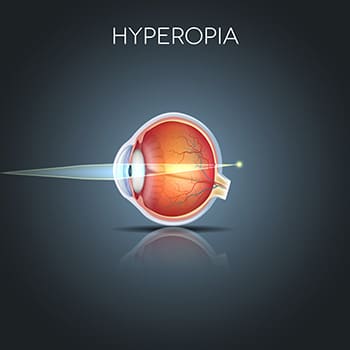Hyperopia
Hyperopia is also called farsightedness, because people who have the condition are not able to focus clearly on objects at close range, though distant objects may be viewed easily without the aid of glasses. Hyperopia is not a disease of the eye, it’s a refractive disorder where the eye does not focus properly.
Signs of Hyperopia can include difficulty with reading, eyestrain and squinting, or headaches. Some people with Hyperopia, especially children, don’t notice any problem with their vision. If the Hyperopia is more severe, objects may be blurry at any distance.


What Causes Hyperopia?
Hyperopia results from the length of the eye, front-to-back, being too short in proportion to the curvature of the cornea, or when the cornea is too flat. As a result, light is not accurately focused on the retinal screen at the back of the eye, but at an imaginary point behind the eye, causing foreground objects to appear blurred.
Depending on the shape of the eye, Hyperopia can vary from very mild to extreme.
How Common Is Hyperopia?
Hyperopia is usually inherited, and most children have it to some degree, but because children’s eyes are so accommodating, many are able to focus well enough that their vision is clear for objects at any distance, especially if their Hyperopia is not too severe.
As children grow, their eyes often grow longer, lessening the severity of their Hyperopia.
How Is Hyperopia Treated?
The most common methods for treating Hyperopia are eyeglasses or contact lenses to change the focal point of the eye. In some cases, people choose LASIK or a similar refractive surgery to reshape the cornea, again changing the focal point of the eye. Neither method is best. What’s best for you depends on your eyes, and on your situation.
Though some people claim that eye exercises, vitamins or other pills can prevent, or even cure Hyperopia, there isn’t sufficient scientific evidence to support those claims.
